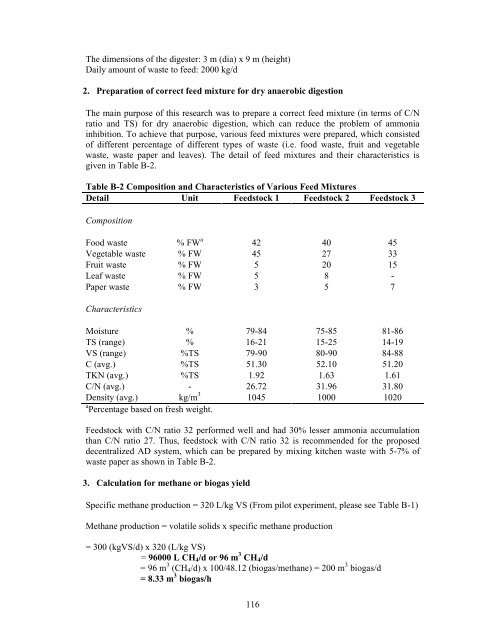dry anaerobic digestion of municipal solid waste and digestate ...
dry anaerobic digestion of municipal solid waste and digestate ...
dry anaerobic digestion of municipal solid waste and digestate ...
Create successful ePaper yourself
Turn your PDF publications into a flip-book with our unique Google optimized e-Paper software.
The dimensions <strong>of</strong> the digester: 3 m (dia) x 9 m (height)<br />
Daily amount <strong>of</strong> <strong>waste</strong> to feed: 2000 kg/d<br />
2. Preparation <strong>of</strong> correct feed mixture for <strong>dry</strong> <strong>anaerobic</strong> <strong>digestion</strong><br />
The main purpose <strong>of</strong> this research was to prepare a correct feed mixture (in terms <strong>of</strong> C/N<br />
ratio <strong>and</strong> TS) for <strong>dry</strong> <strong>anaerobic</strong> <strong>digestion</strong>, which can reduce the problem <strong>of</strong> ammonia<br />
inhibition. To achieve that purpose, various feed mixtures were prepared, which consisted<br />
<strong>of</strong> different percentage <strong>of</strong> different types <strong>of</strong> <strong>waste</strong> (i.e. food <strong>waste</strong>, fruit <strong>and</strong> vegetable<br />
<strong>waste</strong>, <strong>waste</strong> paper <strong>and</strong> leaves). The detail <strong>of</strong> feed mixtures <strong>and</strong> their characteristics is<br />
given in Table B-2.<br />
Table B-2 Composition <strong>and</strong> Characteristics <strong>of</strong> Various Feed Mixtures<br />
Detail Unit Feedstock 1 Feedstock 2 Feedstock 3<br />
Composition<br />
Food <strong>waste</strong> % FW a<br />
42 40 45<br />
Vegetable <strong>waste</strong> % FW 45 27 33<br />
Fruit <strong>waste</strong> % FW 5 20 15<br />
Leaf <strong>waste</strong> % FW 5 8 -<br />
Paper <strong>waste</strong> % FW 3 5 7<br />
Characteristics<br />
Moisture % 79-84 75-85 81-86<br />
TS (range) % 16-21 15-25 14-19<br />
VS (range) %TS 79-90 80-90 84-88<br />
C (avg.) %TS 51.30 52.10 51.20<br />
TKN (avg.) %TS 1.92 1.63 1.61<br />
C/N (avg.) - 26.72 31.96 31.80<br />
Density (avg.) kg/m 3<br />
1045 1000 1020<br />
a<br />
Percentage based on fresh weight.<br />
Feedstock with C/N ratio 32 performed well <strong>and</strong> had 30% lesser ammonia accumulation<br />
than C/N ratio 27. Thus, feedstock with C/N ratio 32 is recommended for the proposed<br />
decentralized AD system, which can be prepared by mixing kitchen <strong>waste</strong> with 5-7% <strong>of</strong><br />
<strong>waste</strong> paper as shown in Table B-2.<br />
3. Calculation for methane or biogas yield<br />
Specific methane production = 320 L/kg VS (From pilot experiment, please see Table B-1)<br />
Methane production = volatile <strong>solid</strong>s x specific methane production<br />
= 300 (kgVS/d) x 320 (L/kg VS)<br />
= 96000 L CH4/d or 96 m 3 CH4/d<br />
= 96 m 3 (CH4/d) x 100/48.12 (biogas/methane) = 200 m 3 biogas/d<br />
= 8.33 m 3 biogas/h<br />
116

















